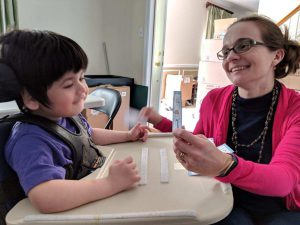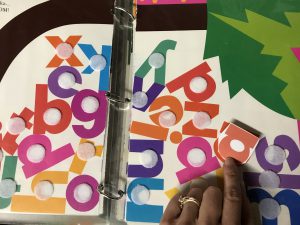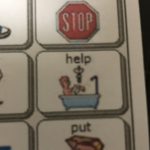 Last week I wrote about discovering that Joey had difficulty counting small sets of objects or pictures. Although he can sequence numbers and identify numerals, he seemed to be getting hung up on the act of counting. I was stumped for a bit. Joey’s unique profile makes it difficult for him to touch items in order to count them, and it is unclear what he actually sees in his visual field. We have no idea if he is seeing double, or if he has difficulty tracking items in front of him. How do you learn to count when you may count the same item repeatedly because you can’t see the items clearly? [Read more…]
Last week I wrote about discovering that Joey had difficulty counting small sets of objects or pictures. Although he can sequence numbers and identify numerals, he seemed to be getting hung up on the act of counting. I was stumped for a bit. Joey’s unique profile makes it difficult for him to touch items in order to count them, and it is unclear what he actually sees in his visual field. We have no idea if he is seeing double, or if he has difficulty tracking items in front of him. How do you learn to count when you may count the same item repeatedly because you can’t see the items clearly? [Read more…]
Choosing His Words Carefully

Joey’s eyes hovered over his device, scanning it for the words he wanted to use. He repeated some words over and over again, and each time I tried to follow up and understand what he was saying. I kept getting it wrong. I’d ask some sort of clarifying question, and he’d go back into his device to repeat the words again, putting them in a different order or adding a new word to the mix. Off. Brown. Down. Turn. Fast. Down. Black. Turn. Yet any comment I made about what he was trying to tell me was met with a head shake. Eventually, a few tears began to run down his face. Through the tears he went back into his talky, looking for new words to make himself clear. [Read more…]
Reflecting on 2017
 As 2017 draws to a close, it is hard to imagine that Joey has only had access to his eye gaze AAC device for a year. A year ago, we were so excited to get started with Joey’s eye gaze system, but also unsure of what it would mean, or even how to use it. Since the eye gaze technology itself is fairly new, we were all learning how to use it right along with Joey. [Read more…]
As 2017 draws to a close, it is hard to imagine that Joey has only had access to his eye gaze AAC device for a year. A year ago, we were so excited to get started with Joey’s eye gaze system, but also unsure of what it would mean, or even how to use it. Since the eye gaze technology itself is fairly new, we were all learning how to use it right along with Joey. [Read more…]
Change of Plans: Reading Chicka-Chicka-Boom-Boom with Joey
 Joey’s hand hovered over mine, with a slow and thoughtful purpose. The intense stare on his face told me that he was telepathically telling his hand to stay where it was, and then open his fingers to release the foam letter he was so forcefully clutching. His focus was similar to what one observes on the faces of college math majors poring over a new problem. He was going to release this letter. Nothing would distract him.
Joey’s hand hovered over mine, with a slow and thoughtful purpose. The intense stare on his face told me that he was telepathically telling his hand to stay where it was, and then open his fingers to release the foam letter he was so forcefully clutching. His focus was similar to what one observes on the faces of college math majors poring over a new problem. He was going to release this letter. Nothing would distract him.
[Read more…]
Success

Those Small Moments of Great Success
I’d just sat down with Joey to read Five Little Monkeys Jumping on the Bed. He was working hard on pulling off the monkeys I’d velcroed into the book when suddenly he stopped and looked at his AAC device.


